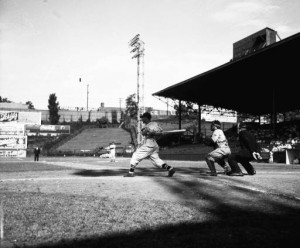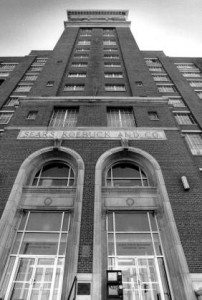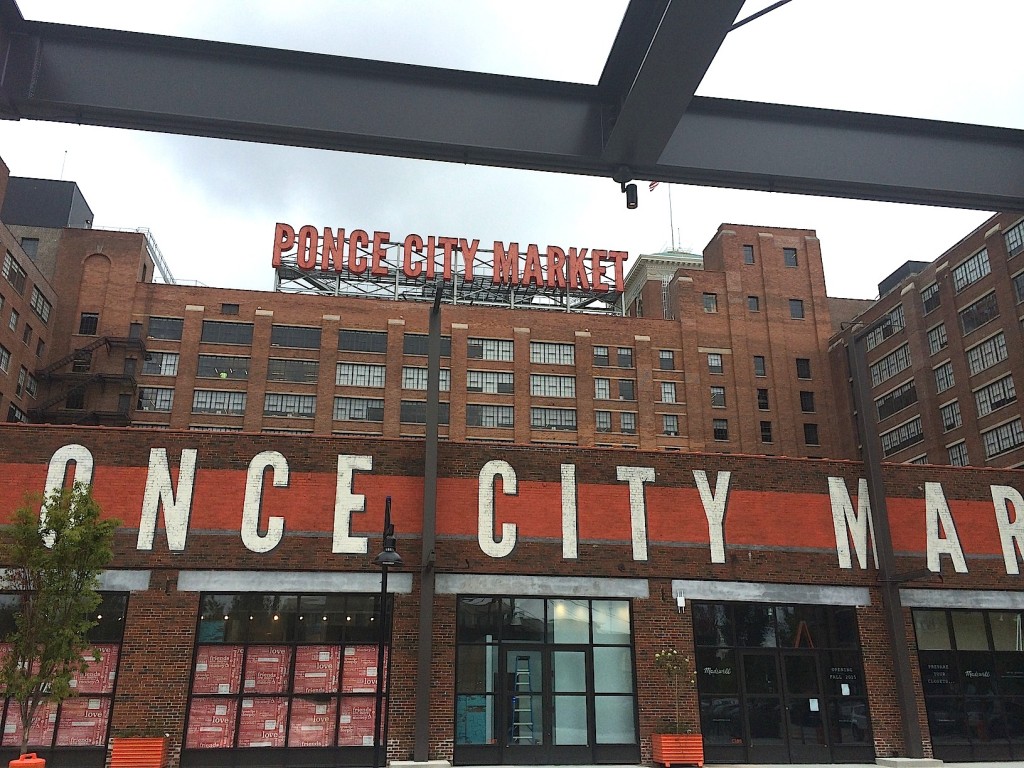Ponce City Market, a mixed-use development, located on Ponce de Leon Avenue, embodies Atlanta’s revitalization. With over a million square feet of retail and residential space, this community is rapidly becoming Atlanta’s most prominent hub for economic consumption. Impressively, this structure is the largest brick structure in the Southeastern United States.
Atlanta’s culture has continuously been shaped by the location’s various landmarks throughout history. Therefore, to examine the culture of Ponce, one must note the previous developments. When the property was first created as Ponce de Leon Springs in the 1860’s, residents gathered to experience the exquisite natural landscape that juxtaposed to the modern, industrial city of Atlanta. The environment provided individuals with an escape from the busy, urban lifestyle. This prompted adventure seekers,

Circle Swing at Ponce de Leon Springs, 1907.
ATLGuidebook1907_029, Historic Atlanta Guidebook Images, Georgia State University Library Digital Collections
suburban families, and city residents to travel to the attraction. Contrast to other prominent urban centers throughout the United States, Atlanta still maintains an earthy, natural landscape.
To this day, Ponce City Market has taken advantage of the springs and utilizes the spring water for it’s own usage. With this integration, the development continues to cut it’s water usage in half, thus helping to conserve water. As the property transformed into recreational and entertainment facilities, Atlanta’s culture adapted to this change. In 1903, Ponce de Leon Amusement Park opened to the public which attracted people of varying ages to enjoy themselves while in the city. Presently, Ponce City Market has built its own amusement park in homage to the original park from the 1900’s. The current park, Skyline, offers mini-golf, exhilarating rides, as well as classic carnival games and food to its residents. The market incorporated the original atmosphere of Ponce de Leon Amusement Park by establishing a “Coney Island” feel with its design. With this new development, Ponce City Market desires to attract a larger demographic that ranges from all ages. Ultimately, as the site transitioned to the amusement park’s recreation, Atlantans followed.

Right-handed Atlanta Cracker swinging at Ponce de Leon Ball Park, 1942.
LBCE2-041a, Lane Brothers Commercial Photographers Photographic Collection, 1920-1976. Photographic Collection, Special Collections and Archives, Georgia State University Library.
The Ponce de Leon Baseball Park, completed in 1907, held countless minor league baseball games. Since the sport of baseball is regarded as America’s true past-time, the venue developed a huge audience of baseball-goers. Hundreds of individuals would devoutly watch the Atlanta Crackers play. For almost twenty years after its construction, the location became a prominent venue for athletics within the city. When examining the current sign at the main entrance of Ponce City Market, the signage embodies a classic American essence – almost as if the letters originated from a retro baseball park. Ponce City recognizes it’s history and yearns to illustrate its fundamentals within it’s revolutionary structure. Additionally, there exists a resurgence of physical activity in Ponce City that parallels with the past efforts of baseball in Atlanta. Now, Ponce City Market fully integrates the Beltline into their location which prompts other modes of transportation apart from vehicles. They advocate activities including walking, biking, and running to promote a healthier lifestyle. During this time, Atlanta desired to become a location that attracted

Sears and Roebuck building, 1987.
AJCP300-001a, Atlanta Journal-Constitution Photographic Archives. Special Collections and Archives, Georgia State University Library.
more than exclusively industrial companies; they wanted to be friendly to families, athletics, and recreation that would include the interest of everyday households. Their construction of various parks illustrated this movement. When the first building developed in 1926, a Sears and Roebuck department store and regional office, the shopping culture within Atlanta escalated. The prominence of store catalog’s assisted in the rise of Sear’s consumer demand. The department store flourished as the central shopping hub for the southeast. If any individual located within this region ordered from the Sears catalog, then it most likely derived from this facility. Sequentially, because of intense popularity, this location became defined by the Sears and Roebuck Department Store. Most notably, the current structure of Ponce City Market intertwines the department store’s original architecture. The market has a freight elevator that was once utilized to carry Sear’s merchandise from one floor to the next. Nowadays, passengers can ride the freight elevator to various floors. From 1926 to 1990, consumer trends and the department store fad heavily influenced the site’s integrity. In the 1990’s, Ponce developed into East City Hall which served as offices for local governmental bodies with little renovation of the building. Nowadays, Jamestown Realty owns the property. They claim that when they purchased the building, it was practically unretouched from the Sears department store.

East City Hall, 1993.
AJCP142-027c, Atlanta Journal-Constitution Photographic Archive. Special Collections and Archives, Georgia State University Library
As they constructed the market, they articulately built upon the 87-year-old building to maintain its rich history. Now, Ponce City Market has created a new culture of Atlanta that encompasses retail, food, residence, and transportation. The alternative clothing stores and prevalent coffee shops establish a “hipster” vibe that are popularized by millennials. The food scene is one-of-a-kind, offering a varieties of cuisines while providing an emphasis of farm-to-table meals. This prompts individuals to eat consciously, focusing on organic, healthy foods. The residential and business space exhibits modernity with industrial design. Innovative business similar to Google Fiber transcend by providing technological advances to everyday consumers. The apartment and business layouts appear industrial which underlies the department store’s presence. The transportation speaks immensely for the culture of Atlanta. Jamestown properties had to build numerous parking lots to meet the needs of vehicular transportation. Since many individuals in Georgia use cars for transport, the market had to develop large spaces to park cars. With various parking garages and parking lots around the market, residents’ dependencies on cars remain clear. More notably, the Atlanta Beltline also intertwines within Ponce. This walking-and-bike-friendly trail system acts as a catalyst for non-vehicular transportation. Individuals now have the opportunity to walk to Ponce City Market on a path exclusively for pedestrians. The trail’s success can be exhibited by the construction of a Beltline entrance to market. Ultimately, the culture has constantly shifted from development to development at the site of Ponce City Market, but the history of the building still remains.
